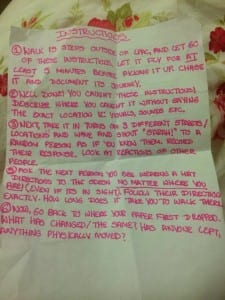Looking further into Marc Auge’s notion of place and non-place, the idea of them overlapping provoked ideas of how non-places in the city can be transferred into places through performance. The group discussed the idea of whether the High Street in Lincoln is a non-place, but I realised that the street was too long to define in such simple terms. Because of this, I began thinking of how small specific areas of the High Street could be non-places.
After a group discussion, we separated into what will be our final performance groups and discussed any similar ideas we had. Once we had identified these similarities, we cleared our minds and all gave input to build possible performance ideas. One idea that intrigued us was using the archway on the High Street to analyse the difference between a non-place and a place. This space is also popular for homeless people to sleep, making us think of what a home means to different people – a homeless person could consider this space a home, and could we display this through performance through changing it from a non-place to a place.
The following week we travelled to the archway to fully explore what was there. Seeing the historic architecture we decided it would be beneficial to organise to take a tour of the inside of the building. This will happen next week and then we can explore any new ideas with the information we gather from the tour. Following the idea of what makes a home, we created a survey that we can ask members of the public in order to gain substantial research for our performance. New ideas were spouted after visiting the site: as we invite audience into the mini home that we create in this place, a picture will be taken of them and added to a wall. This collage will grow as more audience members are added, and the end result will form a family from members of the community, with Lincoln becoming the family’s home.
Questions to think of for our performance processes were brought up in session. Such questions were how much do you perform being the actor? How much of the performance is set up and planned precisely, and how much is left to chance? How much of the performance content will be provided by the audience? These questions will have to be carefully considered during the development process in order to have a sustainable and effective performance.






